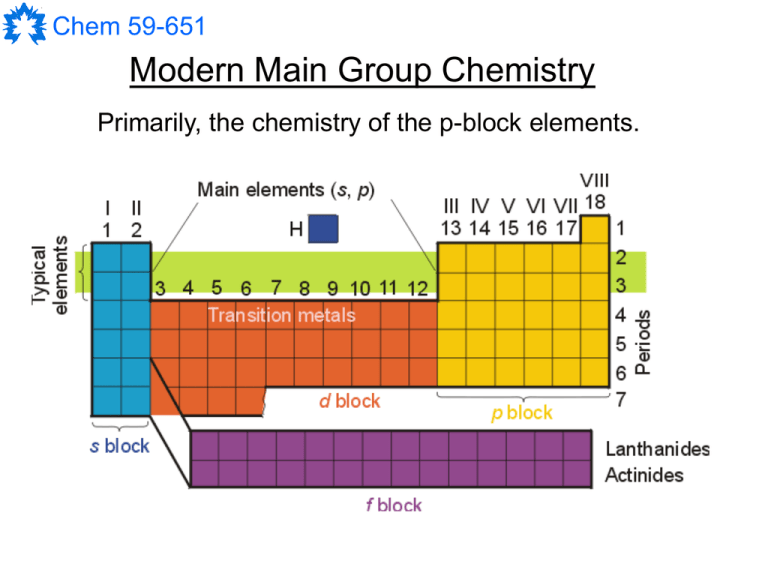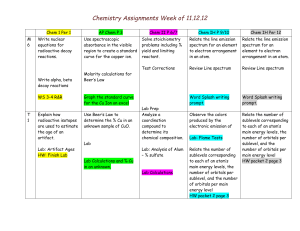Notes 1
advertisement

Chem 59-651 Modern Main Group Chemistry Primarily, the chemistry of the p-block elements. Chem 59-651 Group 1 - Alkali metals Group 2 - Alkaline earth metals Group 13 - Earth metals (Triels) Group 14 - no name Group 15 - Pnictogens (Pentels) Group 16 - Chalcogens Group 17 - Halogens Group 18 - Noble Gases Chem 59-651 Multiple bonds between main group elements Ar Bi Bi Ar Ar Ga Sn Sn Ga Ar What do such compounds teach us about the rules of bonding ? Chem 59-651 Low oxidation state and cluster compounds Chem 59-651 Main Group Metallocenes Cp*2M (M = Be, Al, Mg) Cp*2B+ Cp*2M (M = Si, Ge, Sn) [Cp*2Ga+][AlCl4-] Chem 59-651 Single-source Precursors for Materials AlN InP Chem 59-651 Highly-reactive species: C-H and other bond activation H H CH3 C Al Cp* Al Cp* CH3 N CH3 N H CH3 CH3 R2N P R2N BPh3 R2N BPh4 P R2N Ph Chem 59-651 Concepts/Approaches that we must review - Some aspects of periodicity (effective nuclear charge, electronegativity, the sizes of atoms and orbitals, contractions, relativistic effects) - Valence Shell Electron Repusion Theory (shapes) - Valence Bond Theory (hybridization of orbitals, the use of d-orbitals) - Molecular Orbital Theory and diatomic MO diagrams - Symmetry and Point Groups - Group Theory, Character Tables and polyatomic MO diagrams You can find most of these in Inorganic text books or on my web site. Chem 59-651 Trends for Atomic Properties in the Periodic Table Understanding how and why properties change from element to element requires us to consider: 1. The electron configuration of the atom or ion (the filling order) 2. The type of valence orbitals involved (size, shape, shielding and penetration) 3. The effective nuclear charge felt by electrons in valence orbitals 4. “Oddities” Chem 59-651 Wave functions and Orbitals = wave function 2 = probability density 4r22 = radial probability function E H = Rnl(r)Ylml(,) Rnl(r) – radial function Ylml(,) – angular function polar coordinates Chem 59-651 Nodes: surfaces where there is 0 probability of finding an electron Number of radial nodes = n - l –1 Number of angular nodes: 0 for s orbitals 1 for p orbitals 2 for d orbitals (except dz2) An applet demonstrating nodes for 2D wavefunctions can be found at: http://artsci-ccwin.concordia.ca/facstaff/a-c/bird/c241/java/drums/drums.html Chem 59-651 s orbitals p orbitals Chem 59-651 d orbitals Chem 59-651 Effective Nuclear Charge, Z* The presence of other electrons around a nucleus “screens” an electron from the full charge of the nucleus. We can approximate the energy of the electrons by modifying the Bohr equation to account for the lower “effective” nuclear charge: Z* = Z - Z *2 En R 2 n Z* is the effective nuclear charge Z is the atomic number is the shielding or screening constant Chem 59-651 The prediction and Z* Slater’s rules for the prediction of for an electron: 1. Group electron configuration as follows: (1s)(2s,2p)(3s,3p)(3d)(4s,4p)(4d)(4f)(5s,5p) etc. 2. Electrons to the right (in higher subshells and shells) of an electron do not shield it. 3. For ns or np valence electrons: a) each other electron in the same group contributes 0.35 (0.30 for 1s) b) each electron in an n-1 group contributes 0.85 c) each electron in an n-2 or lower group contributes 1.00 4. For nd or nf valence electrons: a) each other electron in the same group contributes 0.35 b) each electron in a lower group (to the left) contributes 1.00 Chem 59-651 Example with a valence electron on oxygen: O, Z = 8 Electron configuration: 1s2 2s2 2p4 a) (1s2) (2s2 2p4) Z* = Z - b) = (2 * 0.85) + (5 * 0.35) = 3.45 1s 2s,2p Z* = Z - Z* = 8 – 3.45 = 4.55 This electron is actually held with about 57% of the force that one would expect for a +8 nucleus. Chem 59-651 Example with two electrons for nickel: Ni, Z = 28 Electron configuration: 1s2 2s2 2p6 3s2 3p6 3d8 4s2 (1s2) (2s2 2p6) (3s2 3p6) (3d8) (4s2) Z* = Z - For a 3d electron: = (18 * 1.00) + (7 * 0.35) = 20.45 1s,2s,2p,3s,3p Z* = Z - 3d Z* = 28 – 20.45 = 7.55 For a 4s electron: = (10 * 1.00) + (16 * 0.85) + (1 * 0.35) = 23.95 1s,2s,2p Z* = Z - 3s,3p,3d 4s Z* = 28 – 23.95 = 4.05 Chem 59-651 The basis of Slater’s rules for s and p orbitals have better “penetration” to the nucleus than d (or f) orbitals for any given value of n i.e. there is a greater probability of s and p electrons being near the nucleus This means: 1. ns and np orbitals completely shield nd orbitals 2. (n-1) s and p orbitals don’t completely shield n s and p orbitals Chem 59-651 Periodicity of Effective Nuclear Charge Z* on valence electrons H 1.00 Li 1.30 Na 2.20 K 2.20 Rb 2.20 Cs 2.20 Be 1.95 Mg 2.85 Ca 2.85 Sr 2.85 Ba 2.85 B 2.60 Al 3.50 Ga 5.00 In 5.00 Tl 5.00 C 3.25 Si 4.15 Ge 5.65 Sn 5.65 Pb 5.65 N 3.90 P 4.80 As 6.30 Sb 6.30 Bi 6.30 O 4.55 S 5.45 Se 6.95 Te 6.95 Po 6.95 F 5.20 Cl 6.10 Br 7.60 I 7.60 At 7.60 He 1.65 Ne 5.85 Ar 6.75 Kr 8.25 Xe 8.25 Rn 8.25 Chem 59-651 Shielding and Effective Nuclear Charge The energy of valence electrons in an atom/ion changes with the loss of addition of an electron. Slater’s rules are only approximate and can give poor predictions. For example: They ignore the differences in penetration between s and p orbitals. Real s and p orbitals do not have the same energy. They assume that all electrons in lower shells shield outer electrons equally effectively. Chem 59-651 Shielding and Effective Nuclear Charge Effective nuclear charge can be used to rationalize properties such as the size of atoms and ions. Cp*2Be Cp*2B+ Be and B+ are isoelectronic (1s2 2s2) but very different because of effective nuclear charge. Chem 59-651 Orbital energy levels and atomic number For atoms other than hydrogen: Orbital energy depends on n and l Ordering of orbital energies: ns < np < nd < nf Remember: This ordering is due to the different penetrating ability of the different types of orbitals and the different effective nuclear charges felt by the electrons in those orbitals. Chem 59-651 An anomaly of the periodic table The 4s orbitals are lower in energy than the 3d orbitals for K and Ca. This is only for the free atoms! In molecules 3d are lower in energy than 4s! This is assumed to be an accident of nature but it is consistent throughout the table. Chem 59-651 The Size of Atoms and Ions Radii of neutral atoms The atomic radius of an atom is defined as half the distance between the nuclei in a homonuclear bond. r decreases In general: r increases - radii decrease across a period because of increasing Z*. -radii increase down a group because of the increasing distance of the electrons from the nucleus. - increasing distance from the nucleus outweighs effective nuclear charge for atomic radii down a group. Chem 59-651 Remember that the maximum probability for an orbital moves further away from the nucleus with increasing n. 0.1 nm = 1 Å = 100 pm Bohr model for H; radius(n) = n2a0 The “d-block contraction” causes Ga to be about the same size as Al. This is caused by the introduction of the 3d elements which cause a vastly larger Z* for Ga. Chem 59-651 Radii of ions This is a “self-consistent” scale based on O-2 = 1.40 (or 1.38) Å. Ionic radii depend on the magnitude of the charge of the ion and its environment. Positively charged ions are smaller than their neutral analogues because of increased Z*. Negatively charged ions are larger than their neutral analogues because of decreased Z*. Same periodic trends as atomic radii for a given charge Chem 59-651 The utility of covalent and ionic radii The radii tabulated in various books (e.g. Huheey, Keiter and Keiter) allow us to predict the bond length we would expect to see for a new bond. Example: What is the expected bond length for a single Sb-N bond ? For N, rcov = 0.70 Å and for Sb, rcov = 1.41 Å Using these values, an Sb-N bond should be 2.11 Å. The experimental distance is 2.05 Å. For covalent radii, the predictions will be the best for atoms that have similar electronegativities. If the electronegativities are very different, the predicted distance will be too long because it ignores the coulombic attraction. Chem 59-651 Ionization Enthalpy, DH°ie (ionization potential) The enthalpy change for ionization by loss of electron(s) E(g) E+(g) + e- DH°ie “First ionization potential” E+(g) E2+(g) + e- DH°ie “Second ionization potential” > first E2+(g) E3+(g) + e- DH°ie “Third ionization potential” > second … DH°ie increases DH°ie decreases … Chem 59-651 Features and anomalies in the trend of first ionization energies B: [He]2s2 2p1 – p orbitals are more effectively sheilded than s orbitals so smaller Z* and lower DH°ie. (also [He]2s2 is a full subshell) O: [He]2s2 2p4 – first pairing of electrons causes repulsion so loss of one electron is more favourable. Na: [Ne]3s1 – expected from lower Z* and greater distance of the electron from the nucleus at the start of a new shell. Chem 59-651 Features and anomalies in the trend of first ionization enthalpies Group 17 is “normal” – DH°ie decreases down the group as one would expect based on the increasing distance of the electrons from the nucleus. Group 13 has unusual features – DH°ie does not decrease down the group (and is higher for Tl than for Al, Ga or In. DH°ie is greater than expected for Ga because of the greater Z* caused by the presence of the 3d elements. DH°ie is greater than expected for Tl because of the “greater Z*” caused by relativistic effects. Chem 59-651 Electronegativity, X The ability of an atom in a molecule to attract electrons in a bond to itself. Linus Pauling X decreases X increases First Year rule DX > 2 : ionic 2 > DX > 0.5 : polar DX < 0.5 : covalent Traditional scale goes from 0 to 4 with X of F set to 4. Chem 59-651 Electronegativity, X (note: DHd (A-B) = D(A-B)) Pauling’s definition: Pauling reasoned that the dissociation energy of a purely covalent bond A-B should be the mean of the dissociation energies for the homonuclear bonds A-A and B-B. Any additional energy must be caused by electrostatic attraction between A and B (attributed to ionic character in a bond). The ionic character must be related to the difference in the electronegativities of A and B. He calculated this difference as follows: D(A-B),theory = ½ (D(A-A) + D(B-B)) D’(A-B) = D(A-B),experimental - D(A-B),theory D’(A-B) is the ionic resonance energy in kJ/mol (D(A-B) is in eV) XA – XB = 0.102 (D’(A-B))½ A-B A+ B0.102 is a conversion from kJ/mol to eV Chem 59-651 Electronegativity, X (note: DHie A = IPA) Mulliken’s definition: Mulliken figured that the electronegativity of an element must be related to the energies of gaining and losing electrons. Specifically an atom that binds it’s electrons stongly (large DH°ie) and gains other electrons readily (very positive EA or very negative DH°ea) should do the same in molecules. Thus Mulliken calculated the electronegativity of an atom as the mean of the ionization potential and the electron affinity. For A-B, the electronegativity difference between A+B- and A-B+ is given by: Robert Mulliken XA – XB = ½ ([IPA + EAA] – [IPB + EAB]) XA = ½ ([IPA + EAA]) (these are then scaled to fit the 0-4 scale) This method makes a lot of sense, but is not used because values of DH°ea have not been accurately determined for many elements. Chem 59-651 Electronegativity, X The Allred-Rochow definition: The assumption is that the force that will draw an electron toward an atom is proportional to the effective nuclear charge of that atom and related to the distance of the electron from the nucleus. Z* = effective nuclear charge 2 Z*e e = charge of electron Force 0 = permittivity of a vacuum 40r 2 r = atomic radius The equation: X = 0.359 (Z*/r2) + 0.744 puts the calculated values on the Pauling scale. This definition is useful because it can be applied to many more atoms and is one of the most used scales. Chem 59-651 Electronegativity, X There are several other definitions based on different assumptions and methods, such as quantum mechanical calculations (Boyd) or spectroscopic measurements (Allen), but the values for elements usually end up around the same. Trends in electronegativities are similar to those found for ionization enthalpies. Chem 59-651 The trends in electronegativities and ionization enthalpies explain many features of chemistry such as the “diagonal relationship” (X) and the position of the metallic and nonmetallic elements (DH°ie). Electronegativity also lets us predict the polarity of bonds and chemical reactivity. + Si Cl + Si O + H O + H Cl





![The electronic configuration of phosphorus is [Ne] 3s2 3p3](http://s3.studylib.net/store/data/008974852_1-8381577ce936fbfa611892c1a5f109cd-300x300.png)

